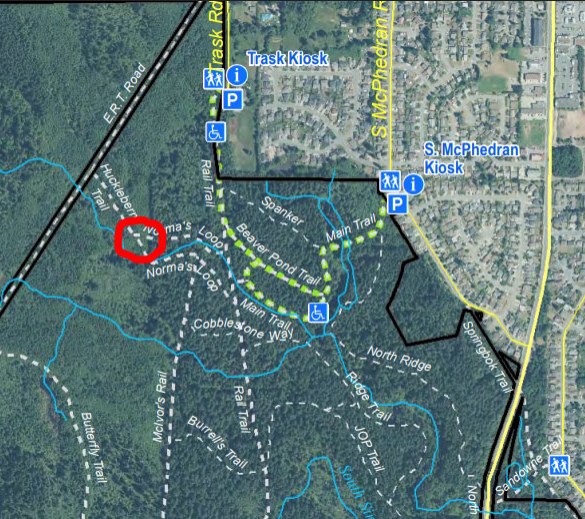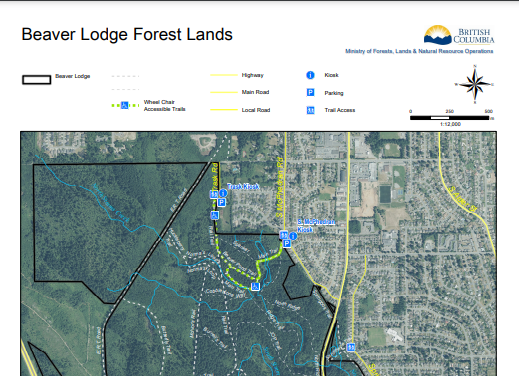Beaver Lodge Forest Lands
The Beaver Lodge Forest Lands are situated on the south western side of Campbell River, B.C. and is home to a complex network of forest ecosystems and a variety of wildlife species. An extensive network of trails have been constructed in the forest providing opportunities for activities.
On this page
- New vegetation in Norma's Loop trail
- History of Beaver Lodge Forest Lands
- Trails in the Beaver Lodge Forest Lands
- Beaver Lodge Forest Lands research
New vegetation in Norma's Loop trail
The Ministry of Forests in partnership with Greenways Land Trust have recently completed riparian restoration at the Simms Creek stream crossing on Norma’s Loop trail. The restoration aims to rehabilitate the riparian zone, where streamside vegetation has been heavily impacted over time. Healthy riparian areas are vital to:
- Stream health
- Erosion control
- Habitat for fish and wildlife
Please respect all signs and fencing that have been installed to protect the newly planted vegetation.
History of Beaver Lodge Forest Lands
In 1931, 1028 acres (416 hectares) of land was donated to the Province of British Columbia by the Elk River Timber Company. Since the original donation, additional parcels have been added to the Lands such that the total area today is approximately 520 hectares. The land was given in trust to be used for experimental work in reforestation and forest management. Historically the land was logged by railway and then reforested through a combination of planted seedlings and naturally-regenerated trees; becoming one of the first operational plantations in B.C. In recognition of the binding obligation of the gift for forestry purposes, Bill 52, the Beaver Lodge Forest Trust Renewal Act resulted in the first experimental forest protected under its own provincial legislation. Since then, the land has been administrated by the Province and accessible for public use.
The Beaver Lodge Forest Lands are situated on the south western side of Campbell River, B.C. within the Simms Creek Watershed and Coastal Western Hemlock Biogeoclimatic Zone. The drier portions of the forest grow well adapted tree species such as Douglas-fir, grand fir, bigleaf maple and red alder. Wetter areas are more favorable to the growth of western hemlock, western redcedar, and Sitka spruce. Experimental planting techniques used in the l930's utilized a variety of tree species generating a parcel of land comprised of diverse habitats. Some of the resulting stands exhibit characteristics of an old growth forest, such as multi-level canopy height, large trees and limbs and a well-developed lower level of vegetation known as the understorey.
The Beaver Lodge Forest Lands are frequented by many wildlife species, including blacktail deer, black bears, cougars, bald eagles, owls, great blue herons, ducks, small birds, beavers, muskrats, coho salmon, cutthroat trout, and amphibians to name a few.
Trails in the Beaver Lodge Forest Lands
Not only an area of high importance to wildlife, residents of Campbell River and visitors alike value the extensive network of trails which provide opportunities for mountain biking, horseback riding, walking, jogging, wildlife viewing and nature appreciation. There are also wheelchair accessible trails from Trask Road and South McPhedran Road parking lots.
When traveling along trails in the Beaver Lodge Forest Lands please consider the following:
- No building or alteration of trails
- Dogs must be kept under control and cleaned up after
- No disturbance of streams and creeks, many are salmon rearing grounds
- Pack out everything you pack in, garbage attracts wildlife
- Keep to established trails
- Respect all trail users as this is a multi-use area
- Respect private property and no trespassing signs
- No fires
- Do not cut trees or remove plants
Be wildlife aware
All wild animals have the potential to be dangerous, bears and cougars being particularly unpredictable. Although an attack is highly unlikely, it is important to be prepared. Should you encounter a bear or cougar stay calm, do not turn your back on the animal and do not run, rather back away slowly. Please be mindful that keeping pets under control mitigates possible wildlife conflicts. To learn more about different species in B.C. and how to stay safe during an encounter, please visit Staying Safe Around Wildlife and WildSafeBC.
Beaver Lodge Forest Lands research
The Beaver Lodge Forest Lands were the site of the first large scale plantation in the province. Early research on how to plant successfully and the survival of various species, form the basis for the present provincial planting and species selection guidelines. The shovel type commonly used by tree planters today was developed during this time.
Since then much of the research has focused on forest management within an urban interface including effects on various plant communities, animal species, and ecosystems. Impacts and mitigation measures focusing on Simms Creek, a salmon spawning stream continue. Forest health and climate change are emerging areas of research within the Beaver Lodge Forest Lands.
The proximity of the Beaver Lodge Forest Lands make them ideal for teaching and are frequently used by local schools and North Island College. Training on appropriate recreation trail maintenance techniques, invasive plant identification and control is conducted in the Beaver lodge Lands.
Contact information
Please direct questions and comments to the Campbell River Natural Resource District Inbox.


